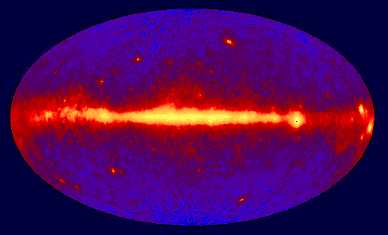| Compton Gamma Ray Observatory | |||||
 |
|||||
|---|---|---|---|---|---|
| The Second Great Observatory for Space Astrophysics | |||||
| Compton | Science | Spectrum | History | Great Observatories | Resources |
| Compton Gamma Ray Observatory | |||||
 |
|||||
|---|---|---|---|---|---|
| The Second Great Observatory for Space Astrophysics | |||||
| Compton | Science | Spectrum | History | Great Observatories | Resources |

NASA closed a chapter after nine exciting years of studying the Universe when it forced the Compton Gamma-Ray Observatory (CGRO) to drop into Earth's atmosphere on June 4, 2000. The huge astronomy satellite burned, broke up and fell in a shower of hot metal on a remote expanse of the Pacific Ocean.
Shuttle Atlantis had placed the Arthur Holly Compton Gamma-Ray Observatory into a low-Earth circular orbit on April 5, 1991. CGRO was designed to study the Universe in an invisible, high-energy form of light known as gamma rays. Weighing in at just over 35,000 lbs., CGRO was the heaviest NASA science satellite ever to be deployed by a space shuttle into low-Earth orbit.
Compton was the second of NASA's four great observatories in space and the first major space observatory to make a systematic survey of natural sources of gamma rays. Still working in Earth orbit are the Hubble Space Telescope and the Chandra X-ray Observatory.
In the controlled crash on June 4, 2000, NASA engineers radioed orders to the 17-ton Compton GRO to carry out a 30-minute series of rocket firings that let it descend from a high orbit. After the craft began breaking up about 2:14 a.m., it took about 20 minutes for some of the lighter pieces to hit the water. An Air Force observation plane watched some six tons of hot metal splash in the Pacific along a corridor starting 2,500 miles southeast of Hawaii and extending 2,000 miles to the southeast. Among the pieces now at the bottom of the ocean are six 1,800-lb. aluminum I-beams and parts made of titanium, such as 5,000 bolts.
Failed Gyroscope. A failed gyroscope had led the U.S. space agency to drop the $670 million astronomy satellite from its orbit 370 miles above Earth. It could have stayed up another 11 years, but officials worried that equipment failures might make the satellite uncontrollable by engineers on the ground as it flew over populated areas such as Miami, Mexico City and Bangkok.
Back in 1979, when the 78-ton abandoned U.S. space station, Skylab, fell from orbit out of control, debris splashed harmlessly in the Indian Ocean and across remote western Australia.
Compton was the first large space observatory to survey natural sources of gamma rays across the Universe. Those invisible rays are the most energetic part of the electromagnetic spectrum.
What Compton found. Compton detected more than 2,600 gamma ray bursts leading astronomers to believe that the bursts occur throughout the Universe. Compton discovered hundreds of previously unknown sources of gamma rays, including thirty exotic objects. It detected gamma rays streaming from black holes, from exploding stars and from our own star, the Sun. Compton data helped astronomers understand how black holes trigger massive jets of X-rays and gamma rays that streak outward at nearly the speed of light.
More than 100 astronomers used the spacecraft to make observations each year. Astronomers have written 2,000 papers from Compton data.
Great Observatories in Space. NASA's Great Observatories for Space Astrophysics had been planned as a family of four orbiting satellites carrying telescopes designed to study the universe in both visible light and non-visible forms of radiation. The first in the series was the Hubble Space Telescope launched in 1990.
The second Great Observatory was the Compton Gamma Ray Observatory launched into Earth orbit from space shuttle Atlantis in 1991. Compton was designed to observe the universe in the gamma-ray portion of the electromagnetic spectrum.
Gamma rays are a non-visible form of light created by nature's hottest and most cataclysmic events. The Compton Observatory satellite telescope allowed study of such enigmatic phenomena as:The Compton Observatory also observed gamma ray bursts. The observatory typically detected one burst per day from random directions in the sky. The sources of those bursts remain a mystery to scientists. Astronomers are trying to decide whether the bursts come from objects surrounding our Milky Way galaxy or from the most distant regions of the observable universe.
- SUPERNOVAS, the explosive death of massive stars
- PULSARS, spinning corpses of supernova explosions
- BLACK HOLES, bizarre results of supernova explosions
- QUASARS, bright central regions of far away galaxies
Learn more about CGRO...CGRO Science Support Center